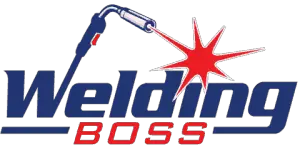This post contains affiliate links to products, services, or education. We may receive a commission for purchases made through links.
To those who don’t have all the fancy welding certifications, understanding the difference between AC and DC welding can be tricky. The AC/DC dilemma can sometimes be misleading, so it’s important to compare the two face-to-face.
So what are the main differences between AC (alternating current) and DC (direct current) welding? The difference lies in the polarity. DC welding is based on a DC straight polarity current, while AC welding alternates quickly between DC negative and DC positive. The applications of each vary with the material.
Here is a handy table to help decipher the differences.
| AC welding | DC welding | |
| Polarity | Alternating polarity | Single polarity; may be positive or negative |
| Common Applications | Aluminum; magnetic materials; thick metals; long seam welds | Most welding applications; overhead/vertical; stainless TIG welding; cutting tap |
| Weld strength | Weaker; heavy spatter | Strong and smooth |
| Arc blow | No | Yes |
| Preferences | Aluminum TIG, fast fill, downhand heavy plate | Constant, stable arc |
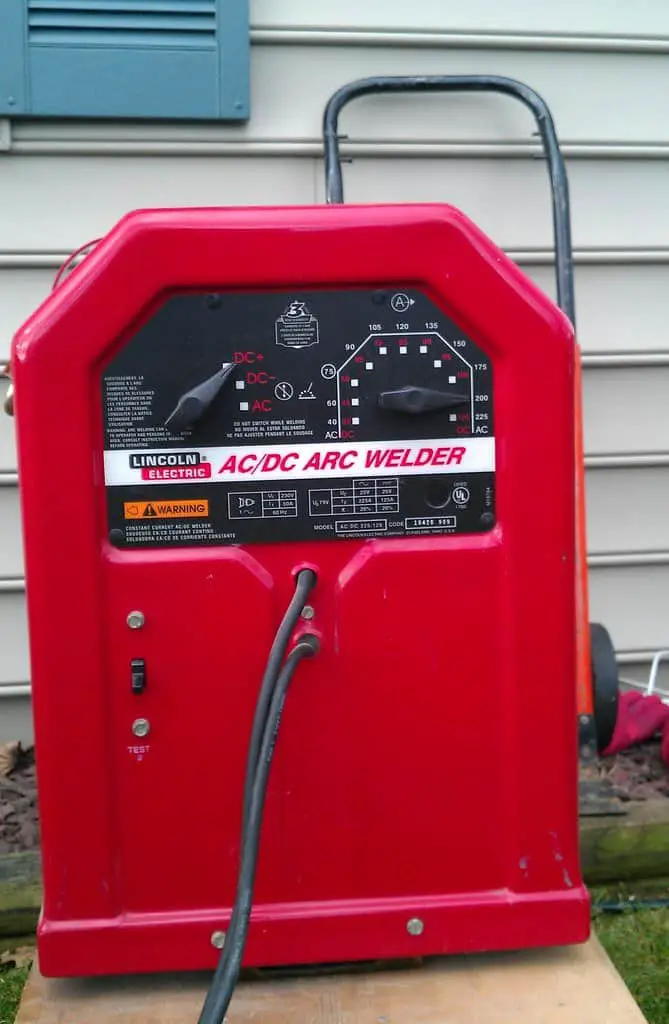
Although DC welding is preferred for most welding applications, AC is handy in some specialized situations. Those applications include TIG welding aluminum; dealing with arc blow; and welding in locations where electrical outlets are limited to 110 volts only. AC is also more common in the small entry-level welders that some folks call “buzz boxes.”
DC welding, on the other hand, is very handy for heavier applications. The welds come out smooth without much spatter, and the welds are much stronger.
DC welders require internal electronic components to convert the alternating polarity to straight polarity. This adds to the size and cost of the machines.
They also usually require 220-volt current, which requires special wiring in the home or shop.
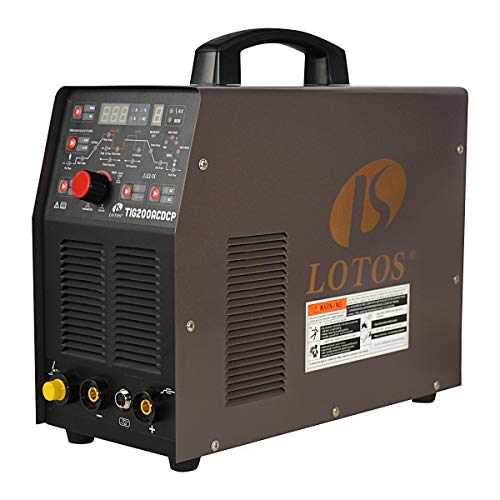
What is AC Welding?
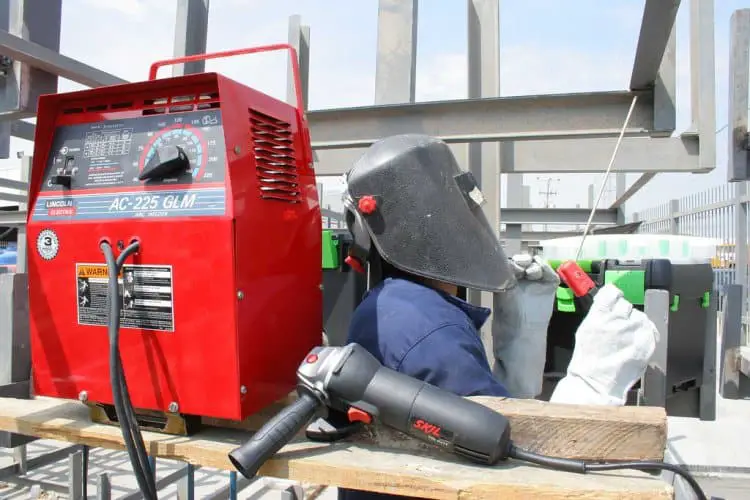
Alternating current describes the electric current used in AC welding. Unlike DC welding, AC uses a current that alternates between positive and negative. Instead of a steady current (straight line), picture a fluctuating current (wavy line) on a graph. Alternating current is the standard for home wiring, so these welders just pass the current on without modification.
Alternating Current (AC) Welding Cons
AC is not the preferred polarity for most kinds of welding. The best results in most situations come from DC welding. Here are some of the biggest drawbacks of AC welding:
- A common event in AC welding is losing the arc. Because the current fluctuates back and forth, the arc needs to restart itself at every turn of the current between positive and negative. Sometimes, the arc cannot restart itself, and you must manually restart it. This can sometimes be an issue to the welder, because it creates a break in the weld, making it weaker.
This is particularly a problem for beginners. It can be hard to consistently crack an arc and keep the weld going. Using a machine that drops the arc makes that even harder. Having to break the weld to redo the job gets old quick.
- Another common issue is spatter. Spatter is the tiny bits of metal debris often found surrounding AC welds. This is a result of the fluctuating current as well. Many types of welding produce spatter, but it’s worse with AC. You will spend more time grinding off spatter if you use this polarity.
However, AC welding is useful in many areas that using DC welding could be more difficult or downright impractical.
AC Welding Pros
Although there are many drawbacks to using AC welding, especially that it creates messy welds, there are also many advantages. AC welding has many useful applications that make it easy to use and practical for repairs in industrial settings.
One of the biggest advantages of AC welding is its ability to be used with metal that has a magnetic field. Sometimes the welding arc will get itself out of alignment with the electrode; it is usually following magnetic currents in the weld metal. This is called “arc wandering,” and it can make it hard to get clean, straight welds.
DC welding is susceptible to arc wandering; AC is not. This comes in handy, especially when repairs on heavy machinery (which often contain magnetic fields of some kind). Construction machinery, logging equipment, and even smaller machines like forklifts are good examples of this application.
AC buzz box welders are used primarily as a second option when 220 current isn’t available, but it’s a good way to get in some welding time when power options are limited, such as in a small home shop or garage. Don’t be discouraged by the high spatter; this is completely normal and is to be expected when AC welding.
Alternating current is also favored for TIG welding aluminum. Aluminum is coated with a very thin layer of aluminum oxide, which interferes with the weld bead. The quick polarity jumps of alternating current have a scrubbing action that breaks up this layer and keeps the joint from contamination.
Although DC welding is generally a better current for most industrial needs, AC welding is very useful to those without access to 220-volt outlet. While you can get a 220 outlet at home, it requires bringing in an electrician. This makes AC a great way to weld at home, fix small appliances and automotive parts, and fabricate anything that doesn’t need to look “pretty.”
What is DC Welding?
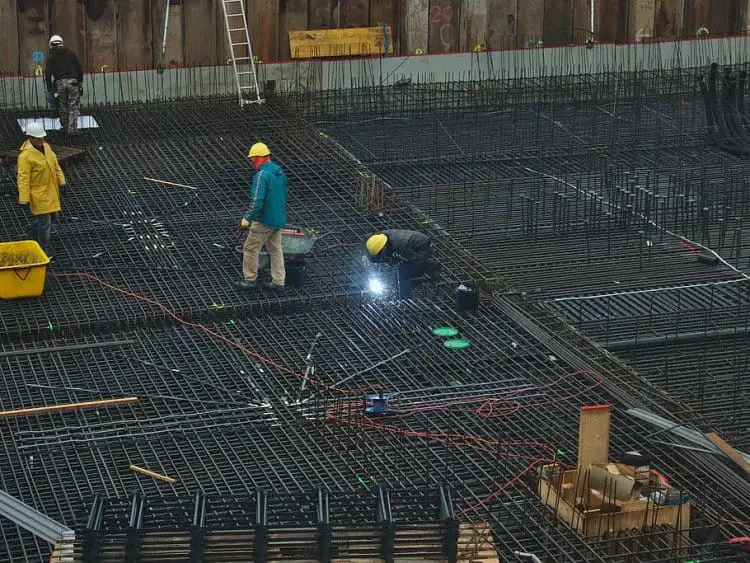
DC welding uses a direct current to supply electricity to an electrode that joins the two metals being welded together. When you pictured the wavy line on a graph, it fluctuated back and forth. This type of welding would look like a straight, steady stream on a graph, which prevents the arc from stopping constantly upon each polarity change.
Direct current can use electrode-positive or electrode-negative polarity. Negative polarity has the current flow from the welder to the electrode to the workpiece back to the welder. Positive polarity has the current flow from the welder to the workpiece to the electrode then back to the welder.
Electrode-negative polarity is sometimes referred to as “straight” polarity. It is preferred for most welding jobs. Straight polarity results in a hotter arc and faster electrode melting. This lets you lay down the bead faster and be more productive. Unless you have a special need for something else, straight polarity DC is almost always the way to go.
Electrode-positive, or “reverse,” polarity produces much deeper penetration. It is preferred for welding thick material. The process is slower than straight polarity, but it’s best if you are working on thick material. You need to work slower with reverse polarity, but that’s an advantage if you are working with metal that is more than about half an inch thick.
Direct Current (DC) Welding Disadvantages
DC welding, although it produces overall better welds, has a few drawbacks that make it harder to use in everyday applications. In some cases, these flaws make it difficult to use DC welding in areas where it might be best.
The biggest disadvantage is the cost. DC currents are not supplied to electrical grids, so an internal transformer must be used in order to change the AC current to DC. The transformers add weight and complexity to DC welders, making them more expensive. DC machines also require 220-volt circuits, which means you’ll need to call an electrician. That can cost as much as the welder itself.
Arc blow is also a problem with DC welding. Magnetic currents in the weld metal will pull the arc out of alignment with the electrode and ruin the bead. Because arc blow is such an issue with DC welding, many welders prefer to AC welding in almost all applications. Arc blow isn’t a problem with AC welders because the arc polarity flips too fast for the arc to be moved.
There are fewer issues in general when using DC welding than AC, but DC welding demands more of the operator in skill and in resources. Although DC welding is more expensive, it is the preferred current for many professional welders. If you are serious about welding, or if you want to use MIG or TIG, opt for direct current.
DC Welding Pros
Despite the flaws of using DC welding, there are also circumstances that call for it before the use of AC welding. In situations where a smooth, aesthetically pleasing weld is desirable or necessary, DC welding is the way to go for its smooth welds with minimal spatter and steady, non-changing polarity.
Perhaps the best use for DC welding is in places where the welds are visible and must be visually appealing. Common instances include furniture, vehicles, and tools. DC welding is also useful in making parts that need to stand up to extreme pressure or abuse.
Some examples of DC welding applications include tow hitches, chassis, gussets, large fuel tanks, and crossmembers. These types of applications require the welds to hold strong for extended periods of time and look clean.
The Machines
First, I found this very entertaining guide to AC vs DC welding machines. As a hobby welder myself, I felt it spoke to people in my situation very well. Check this out…
In the sections below, we’ll look at the differences between the actual machines. All welders work on the same basic principle.
High-voltage electricity flows through an electrode to the joint you are welding.
The electrode heats the metal along the joint to melting, and it flows together. A filler rod adds a little extra metal to guarantee the joint fills in properly.
There are three basic welding processes for home welders. The comparison between each kind of welder is virtually endless, so here’s a quick summary of what to expect:
AC Welding Machines
Current isn’t the only difference between AC and DC welding. AC-only welders are usually limited to arc welding, while DC machines are available for arc, MIG, and TIG welding. If you really can’t decide, there are some welders available that can switch back and forth. Of course, this feature adds cost to the welder.
AC welders tend to be smaller and more compact. They are also cheaper in comparison with DC welders and tend to be more portable. Being lightweight allows these machines to be easily accessible at work sites, for building and machinery repair purposes.
In addition to being convenient and affordable, AC welders are also easier in general to operate. The arc blow in AC machines ranges from nonexistent to easily controllable, and the machines use 110-volt outlets. These machines are easy to move around a jobsite for different projects.
DC Welding Machines
DC welders are the brutes in the size competition. Large, heavy, and difficult to move, DC welders are clunkier but sturdier in the end. Their size makes them ideal for heavy-duty and industrial applications beyond fixing the occasional car or household metal casualty.
Unfortunately, DC welding machines are spendy. That’s why many beginners will opt for the AC first, but welding pros and businesses with a heavy workload for welding benefit from having a bigger unit on hand. DC welders are great for shop and warehouse settings- that is, where 220-volt current can be made available.
Stick Welding
Stick welding, or shielded metal arc welding, is a type of welding that requires the use of a metal filler rod and electric current. This metal rod is called the electrode. It has a coating made up of compounds that help bind the metals to be welded together and prevent contamination of the weld. The coating is called “flux.” Flux is used in various forms in many welding processes.
The electrode itself conducts electricity; this is where the current comes flows. In this process, the electrode (stick) serves as a filler metal to join the two welded metals together. As the electrode melts under the heat, the coating produces a small cloud of gas that protects the metal from oxidizing as it’s applied.
Check out some of our stick welding protective gear.
Can You Use AC Rods in a DC Welder and Vice Versa?
No, you cannot use AC rods in a DC welder or DC rods in an AC welder. It is possible, however, to use AC or DC rods in an AC/DC welder. All you to do is set the correct polarity (consult the machine instruction manual for exact instructions for each machine).
The reason for this is that the filler metals used for each welding process are different. The conditions vary greatly between and AC and DC welder, so it’s bound to be an absolute disaster if the wrong sticks are used.
MIG Welders
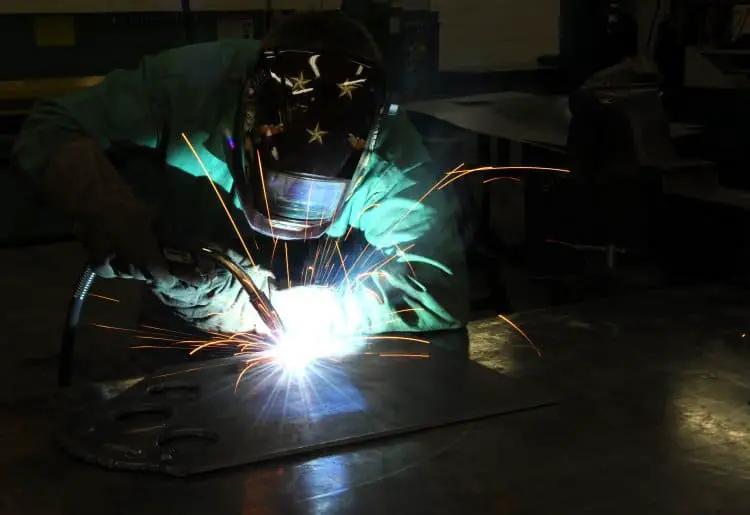
Metal Inert Gas (or MIG) welding is a process that feeds wire from a spool to act as electrode and filler metal. This wire doesn’t have the flux coating that an arc rod has, so the welder also feeds a shield gas over the weld to protect the bead. The filler metal used and the gas is dependent upon the metals being welded together.
MIG welders are great to use as the first line of learning. Since they feed the filler wire at a constant rate, it is easy to get a consistent bead. MIG welders are easier to handle and more forgiving to beginner mistakes.
Flux Core Welding
Flux core welding is somewhat comparable to MIG welding in that it relies on a wire-feed system. Some welders are capable of both MIG and flux fore welding. However, flux core welding is self-shielding and does not require the use of a shielding gas. The wire fed through the system is different from MIG welding in a unique way.
The wire fed into the flux core system is hollow and filled with flux. This way, there is no need to use a shielding gas to prevent the arc from being disturbed. A flux core wire is a great way to weld without the use of extra gasses, but flux core wire is generally pricier than other types of welding wire, so it’s not the best option for if you’re looking to keep expenses low.
TIG Welders
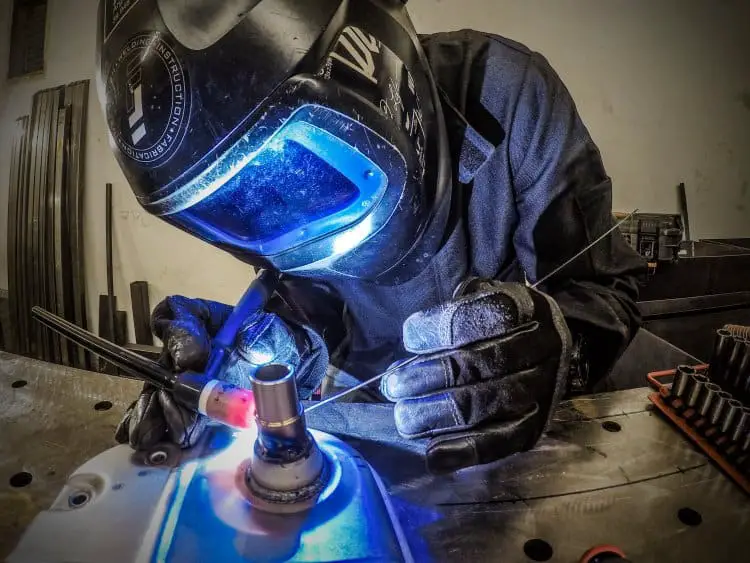
TIG welders operate slightly differently. Instead of a consumable electrode made of filler material, TIG welders use a non-consumable electrode and a separate filler rod. The electrode is used to heat the metal and create a weld puddle. The filler rod is dabbed repeatedly into the puddle to make a bead. TIG welding is noted for making very attractive weld beads.
Welding with a TIG welder is also a great way to produce tidy-looking welds. Unlike the spatter of a MIG welder, TIG produces almost no spatter, so extra measures for sanding and polished are not usually necessary. This application is great for metal that can be seen openly on a finished product, like a piece of equipment or metal furniture.
Unfortunately, with TIG welding comes strict coordination and control by the welder. For this reason, many companies that manufacture TIG welders also offer CNC (computer-numerically controlled) components that allow the use of a robot to maintain consistency throughout the welds. Otherwise, the welder would need to be very skilled and experienced to do this.
AC/DC Welders
There are welders on the market that can weld with both alternating and direct current. There are single-process welders (TIG-only, for example), while others are multi-process machines. Multi-process welders might be able to use two of the three main processes, or even all three.
AC/DC welders are more flexible than single-polarity machines, and multi-process welders are more flexible still. These machines can handle any task you want to take on. Of course, the big drawback to AC/DC welders is the price. Adding capability means adding expense. They are great if you want to take on everything, but you’ll have to pay for it.
How to Tell Which Type of Current to Use
When choosing which kind of welder to buy, it can be difficult to sift through all of the advertisement information to really find out what you’re getting. If you already have a welder, or even both an AC and DC welder, it can be tricky to decide which one to use for a certain project or application.
Essentially, here is what you’ll want to use DC welding for:
Welding overhead or at an unusual angle
The extra spatter from AC welding is a bigger problem when you are working overhead. Instead of getting spatter on the piece being welded, you get spatter on yourself and your work area. Direct current reduces spatter and keeps things cleaner and safer. If you do lots of overhead work, stick with direct current.
Thinner metals
You can work a little faster with DC welds, which is good for thin metal. If you move too slowly on thin stock, you can burn through the metal, causing more problems. Speed is important for welding sheet metal. Anything that slows you down can lead to burning through the stock – use DC for sheet metal.
Most TIG Welding
Most kinds of TIG welding work best with DC. Steel, stainless steel, and copper all TIG weld best with direct current. Good penetration, a smooth bead, and strong joints all come from TIG welding with DC. Some TIG welders are AC/DC to allow you to work with aluminum, but the rest are DC-only. They don’t make AC TIG welders.
Single-Carbon Brazing
Like TIG welding, this process uses a non-consumable electrode and a separate filler rod. This requires a straight-polarity DC setup. Reverse polarity will catch the electrode on fire, and AC will disintegrate it. Single-carbon brazing will only work with straight-polarity direct current.
Here are some examples of when to use AC welding:
Small home applications
Many of the small, buzz-box style AC welders will work on household current. You don’t have to call an electrician to set up for these entry-level welders. If you are just starting out, or if you want a portable welder to take to your buddy’s shop, AC is the best bet.
Machinery
Various parts of heavy equipment can get magnetized, which calls for AC welders. It’s also a little easier to work on rusty or dirty equipment with AC stick welders than other processes. It is also easier to work outside with stick welders than other types, which lends itself to AC machines.
TIG Welding Aluminum
The quick polarity reversals of alternating current have a cleaning effect on aluminum. This keeps the oxide layer from contaminating the weld bead and weakening the joint. High-quality TIG welders have AC settings optimized for aluminum. If you want to TIG weld aluminum, make sure to get an AC/DC TIG welder.
Shipbuilding / Repairing
Long, straight joints between plates work best with the deep penetration of AC welding. The most cited example of this is shipbuilding. However, if you are welding up a thousand-foot-long Panamax freighter or an aircraft carrier, you should really consult the engineering specs and not the internet.
Around Magnetized Fields
Anywhere magnetic fields can cause arc wandering, it’s best to use an AC welder. Magnetized fields are more common in steel with high nickel content or in pipes that have been buried for a long time. It’s also a problem in deep groove joints or inside corners of fillet welds. These are all good candidates for an AC rather than a DC welder.
When an AC/DC welder makes sense:
Jack of All Trades
If you run a small welding shop and need to be able to handle anything that comes through the door, a highly flexible welder makes a lot of sense. With just a few tweaks of switches on the welder, you can run alternating or direct current, and use arc, MIG, or TIG welding.
Money Is No Object
Sometimes we get lucky. Maybe you bought the right scratch-off ticket, or maybe Great Aunt Hortense passed and left you some cash (sorry for your loss, by the way). At any rate, there are times in life when you’ve got money to blow. If you are there, spend some cash on a high-quality AC/DC welder. You will be able to take on all kinds of welding jobs, and you won’t be sorry you did.
The Takeaway
There are many different kinds of welders, and each has unique specifications that require specific materials and currents. The important difference is between alternating currents and direct current welders.
Understanding this distinction is important when deciding what kind of welding to use for a project or which type of welder to buy. Small AC welders will work on 110-volt outlets, while bigger welders need 220-volt current to work best. Most home garages and shops don’t have 220 outlets, so remember to check if you plan on buying a DC welder.
(If you do decide to get a DC welder that requires 220, an electrician can set up a breaker and an outlet in your shop or garage. It’s not dangerous – 220 is the same voltage used by clothes dryers, ovens, and HVAC systems. Most people don’t weld, so garages aren’t built with 220-volt circuits available.)
AC welders are generally the best place to start when you decide to take up welding for the first time. Cheaper and more convenient to own, AC welders may not supply the perfect welds, but their versatility makes them the best option for every welding application under the sun.
If you need something hefty and professional, a DC welder will do the job. However, if the welding you need to get done is in the field or at home in the garage, an AC welder will help you get started without any risk of arc blow, making the job quicker and easier.
*image credit: https://www.flickr.com/photos/natematias/6575916393
